2013
Western States Rural Transportation Technology Implementers Forum
June 18th-20th, Yreka, California

SCHEDULE OF EVENTS
Tuesday, June 18, 2013
4:00 pm to 7:00 pm Registration
5:00 pm to 6:30 pm Reception (no-host)
6:30 pm to 9:00 pm Dinner Reception
Wednesday, June 19, 2013
7:00 am to 8:00 am Breakfast
8:00 am to 8:10 am Welcome and Introductions
8:10 am to 12:00 pm Technical Presentations
12:00 pm to 1:00 pm Lunch
1:00 pm to 5:00 pm Technical Presentations
5:00 pm to 5:15 pm Comments, Discussion, Evaluations
6:00 pm to 9:00 pm Dinner and Networking Session
Thursday, June 20, 2013
7:00 am to 7:45 am Breakfast
7:45 am to 7:50 am Introduction and Overview
7:50 am to 1:00 pm Technical Presentations / Demonstrations
1:00 pm to 1:45 pm Concluding Remarks, Evaluations
1:00 pm to 1:45 pm Lunch
PRESENTATIONS AND DEMONSTRATIONS*
CCTV Image Relay
Keith Koeppen, P.E.
Caltrans District 2
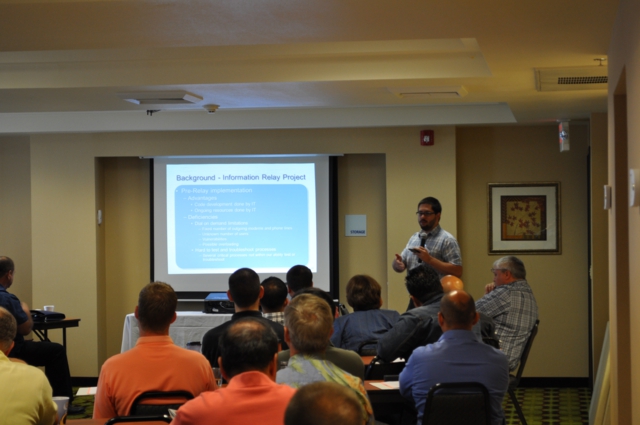
|
|
In California, one of the most used publically available data assets are the CCTV images on the Caltrans public web portal.
Typically, the image data is retrieved from field elements and deposited on the Caltrans public web portal server using two
types of communication networks (field element network, administrative network). In order to retrieve data from the field
elements and deposit that data on a web server located on the administrative network, Caltrans District 2 uses an Information
Relay. In rural ITS deployments there are several key factors that must be overcome to provide timely, accurate, and perceived
reliable data. Mr. Koeppen explained how the CCTV Image Relay was designed to be robust enough to effectively deal with
slow or unreliable rural field communications. He described and demonstrated the additional add-on features of the relay
including geo-location, timestamps, general image processing, and image integrity validation. The technical architecture,
software development, and deployment difficulties associated with the Caltrans District 2 CCTV Image Relay were all discussed.
Timing File - Handout
|
Design and Implementation of Video for Rural ITS – Nevada Department of Transportation
Israel Anthony Lopez
Nevada Department of Transportation
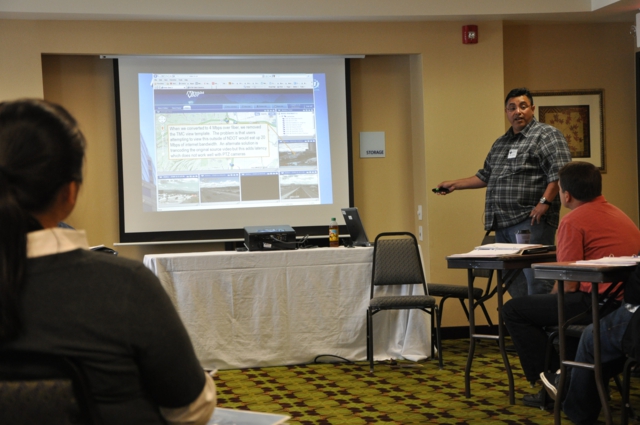
|
|
The Nevada Department of Transportation has deployed ITS video devices at several remote locations throughout
the state to provide better roadway information for the department, Public Safety Officials, and the public.
This system provides video to two different audiences with varying requirements – the public and public safety
officials. Mr. Lopez gave a detailed description of the design and implementation of the video system including
background theory, design criteria, system description and components, maintenance requirements, and initial
and lifecycle costs. Calculations used to determine system requirements (e.g., bandwidth, licensing, resource
allocation) were presented and discussed. Mr. Lopez included a live demonstration of the system that allowed
participants to observe the actual output of the video system and how it applies to the different audiences.
|
Automated Wind Warning System – Caltrans, District 9
Phil Graham
Caltrans District 9

|
|
Mr. Graham from Caltrans District 9 presented their practical, economical, and high value Automated Wind Warning
System. The system includes a solar power system, flashing beacons, RWIS, unlicensed RF links, and a cell modem
for IP communication. Mr. Graham described the design considerations, system components, and the challenges associated
with deploying the system. Examples of data and the related notifications were also included.
|
Bike Detection in California
Martha V. Styer, P.E.; Kai Leung, P.E.
Caltrans, Headquarters Division of Traffic Operations

|
|
California vehicle law 21450.5 (2008) mandates that new or upgraded traffic actuated signals must
detect bicycles and motorcycles. Martha Styer and Kai Leung from Caltrans Headquarters explained
the various issues and solutions currently being used for reliable bicycle detection particularly
in rural areas. One solution being tested is a microwave radar detector that can distinguish between
bikes and cars. The most recent testing results for the system were presented and discussed. The
team also discussed emerging technologies, in particular a system that can detect any vehicle already
inside an intersection and then operate a signal accordingly.
|
Procuring the Advanced Transportation Controller (ATC) for the Oregon Department of Transportation and the State of the National Standards
Doug Spencer, P.E.
Oregon Department of Transportation
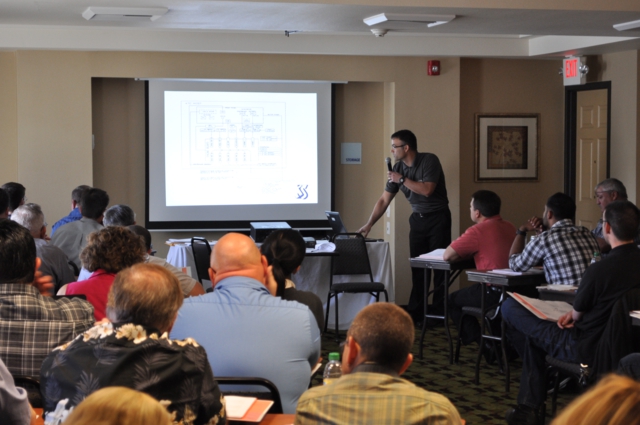
|
|
The Oregon DOT recently issued a Request for Proposals (RFP) to establish a long term price
agreement for the Advanced Transportation Controller (ATC) and an additional RFP for ramp metering
firmware, other firmware, and programming services for the ATC. The second RFP allows ODOT to use
off the shelf software built for the ATC or develop custom firmware to run the agency’s ATC.
ITS Standards Engineer Doug Spencer, explained ODOT’s need for a Controller, the relevant standards
and requirements, the proposal process, subsequent testing, and the challenges that arose throughout.
|
Field Element Data Quality Control from the Perspective of Data Redistribution
Doug Galarus
Western Transportation Institute
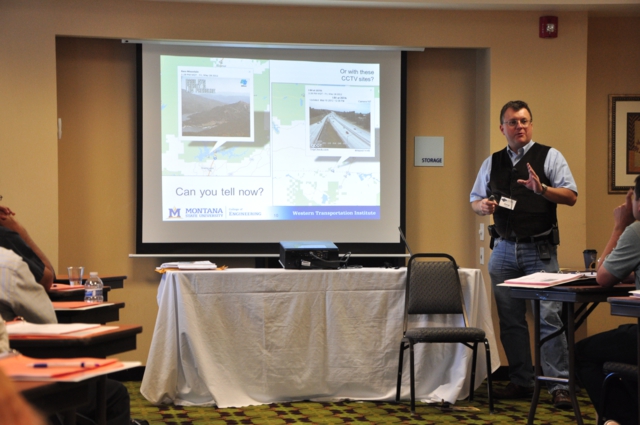
|
|
The Western Transportation Institute, in partnership with Caltrans and other members of the Western
States Rural Transportation Consortium, have conducted a number of research and development projects
over the past 10 years in which DOT field element data and other third party data has been aggregated
and redistributed for the provision of traveler information and support of maintenance and operations
activities. A challenge in all of these efforts has been the assessment and control of quality of the
data presented. Common problems are incorrect metadata, including incorrect station locations, and the
inclusion of erroneous data from sensors. Mr. Galarus discussed the data quality control efforts to date
on these projects as well as the quality control methods used by other data providers. He also demonstrated
the potential for further automation of quality control processes through the use of archived, multi-provider
data.
|
Design and Implementation of Nevada DOT’s Wireless Point to Point and 3G/4G Rural Networks
Jim Whalen
Nevada Department of Transportation
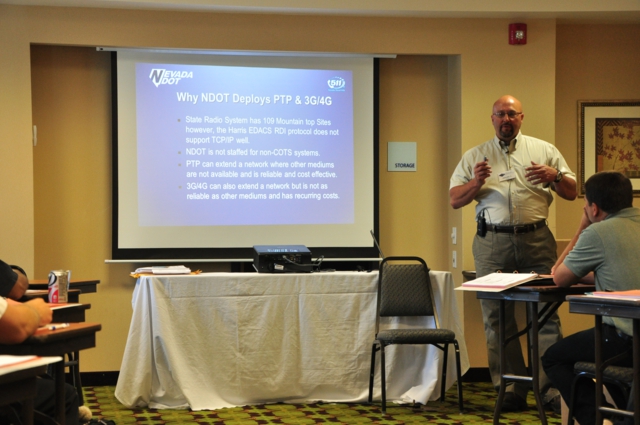
|
|
The Nevada Department of Transportation has deployed ITS devices at several remote locations throughout the
state where commercial wired telecommunication infrastructure sources were either unavailable or cost prohibitive.
Mr. Whalen provided a detailed description of the design and implementation of working wireless Point to Point
(PTP) and 3G/4G cellular systems for a rural ITS installation, including background theory, system description,
and selection of system components based on ITS device communications requirements and cost. He described the
design methods used to determine best practices and the appropriate system for ITS Smart Zones in addition to
network performance and capabilities for ITS device requirements. Mr. Whalen included a demonstration of both
platforms used in NDOT’s rural ITS application to allow participants to observe the actual output of the photovoltaic
system components under varying environmental conditions.
|
Idaho’s Winter Performance Measures
Dennis Jensen
Idaho Transportation Department
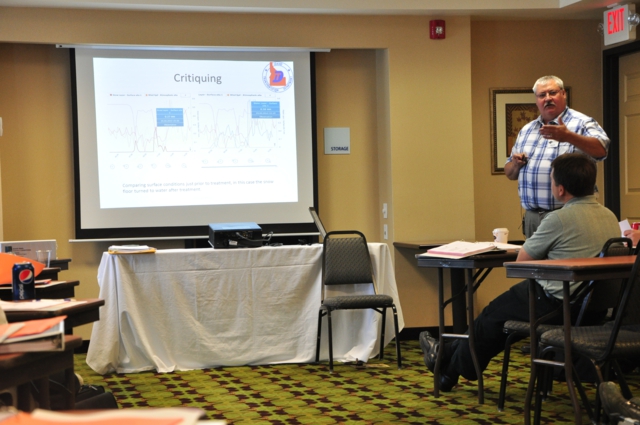
|
|
Timely and efficient winter road maintenance is a high priority for the Idaho Transportation Department and a variety
of treatment materials are employed by a winter maintenance operation fleet of over 500 vehicles. ITD also has a
statewide network of Road Weather Information Systems (RWIS) used to monitor atmospheric and pavement conditions.
Until recently, the analysis and maintenance decisions and procedures driven by the RWIS data were not standardized across
the state. Dennis Jensen, ITD’s Winter Maintenance Coordinator, described how ITD has developed two winter maintenance
performance measures that are calculated from the RWIS data and how those measures are being implemented in operations activities.
He provided details on the development of the performance measures, data collection, and the calculations involved, as well as
2012-2013 winter statistics and the web presentation of the performance measures.
|
Error Assessment for Emerging Traffic Data Collection Devices
Yegor Malinovskiy, Jonathan Corey, Yinhai Wang; University of Washington
Ted Bailey, Ron Vessey; Washington State DOT
Bahar Namaki, Aalborg University

|
|
The ability to produce reliable and accurate performance measures of transportation facilities is becoming increasingly
important while the relatively new capability of relaying traveler information back to the users through smart devices
and in-vehicle systems is gaining interest. The Washington State DOT has instrumented two corridors to evaluate the
effectiveness of several different data collection devices side by side. The University of Washington (UW) is conducting
the study. Yegor Malinovskiy and Jonathan Corey from UW presented an overview of the project and the technologies being
studied and then delved into the project methodology, data analysis, and detailed study results.
|
TOP
*These presentations are posted as developed by the speakers and presented at the 2013 Forum. Alternative accessible formats of these documents can be provided upon request. Persons with disabilities who need an alternative accessible format of this information, or who require some other reasonable accommodation to participate, should contact Neil Hetherington, Visual Communications Manager, Western Transportation Institute, Montana State University, PO Box 174250, Bozeman, MT 59717-4250, telephone number 406-994-3566, e-mail: hetherington "at" montana.edu; or Dana May, Business Development Manager, Western Transportation Institute, Montana State University, PO Box 174250, Bozeman, MT 59717-4250, telephone number (406) 994-6361, e-mail: dana.may "at" montana.edu. |











